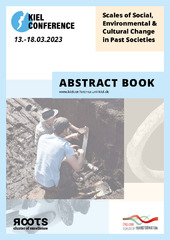Приказ основних података о документу
Household-based food production and the social fabric in the Neolithic Vinča culture of the central Balkans
| dc.creator | Obradović, Djurdja | |
| dc.creator | Dimitrijević, Ivana | |
| dc.creator | Bulatović, Jelena | |
| dc.creator | Filipović, Dragana | |
| dc.date.accessioned | 2023-11-21T18:39:22Z | |
| dc.date.available | 2023-11-21T18:39:22Z | |
| dc.date.issued | 2023 | |
| dc.identifier.uri | http://rai.ai.ac.rs/handle/123456789/727 | |
| dc.description.abstract | Architectural, artefactual and subsistence evidence from sites of the Late Neolithic Vinča culture network (5400-4500 BC) in southeast Europe suggests that the autonomous household was the basic socio-economic unit. Archaeological reconstructions posit that one or several adjacent buildings define individual households, and that these (groups of) structures were the context of economic, social and ritual activities. How/where/when these activities were conducted was likely defined at the communal level, prescribed by supra-household social controls and embedded in ideological framework. Although no clear indications of social stratification are observable at Vinča culture sites, some interhousehold status competition would have been present and was negotiated through mechanisms such as sharing and exchange, and communal works and events, the latter, for instance, documented by the faunal evidence of feasting. Within the community-wide pattern of behaviour that ensured cohesion, social differentiation could have been maintained through household-specific food-related practices, food choices and culinary traditions. These could have served to emphasise individual affinities and identities, to delineate the smallest social units, without damaging the sense of community. As such, they may have even been encouraged. In this presentation, we look at the archaeobotanical and zooarchaeological evidence of food production and consumption from a selection of Vinča culture households, and reconstruct the sources of food, their origin and seasonality. We compare the observations for individual cases, in order to identify potential inter-household differences in the choice and use of (key) resources. We speculate on what effect such differences could have had on the social fabric of the community: whether through them the social bonds were strengthened, undermined, or both; and whether this was of relevance in the context of the dissolution of the Vinča culture. | sr |
| dc.language.iso | en | sr |
| dc.publisher | Kiel : Kiel University Publishing | sr |
| dc.rights | openAccess | sr |
| dc.rights.uri | https://creativecommons.org/licenses/by-sa/4.0/ | |
| dc.source | Kiel Conference 2023: Scales of Social, Environmental and Cultural Change in Past Societies, 13-18 March 2023, Kiel, Abstract book | sr |
| dc.subject | Late Neolithic | sr |
| dc.subject | Vinča culture | sr |
| dc.subject | archaeobotany | sr |
| dc.subject | archaeozoology | sr |
| dc.title | Household-based food production and the social fabric in the Neolithic Vinča culture of the central Balkans | sr |
| dc.type | conferenceObject | sr |
| dc.rights.license | ARR | sr |
| dc.citation.spage | 46 | |
| dc.identifier.doi | 10.38071/2023-00120-3 | |
| dc.identifier.fulltext | http://rai.ai.ac.rs/bitstream/id/1655/Download.pdf | |
| dc.type.version | publishedVersion | sr |


